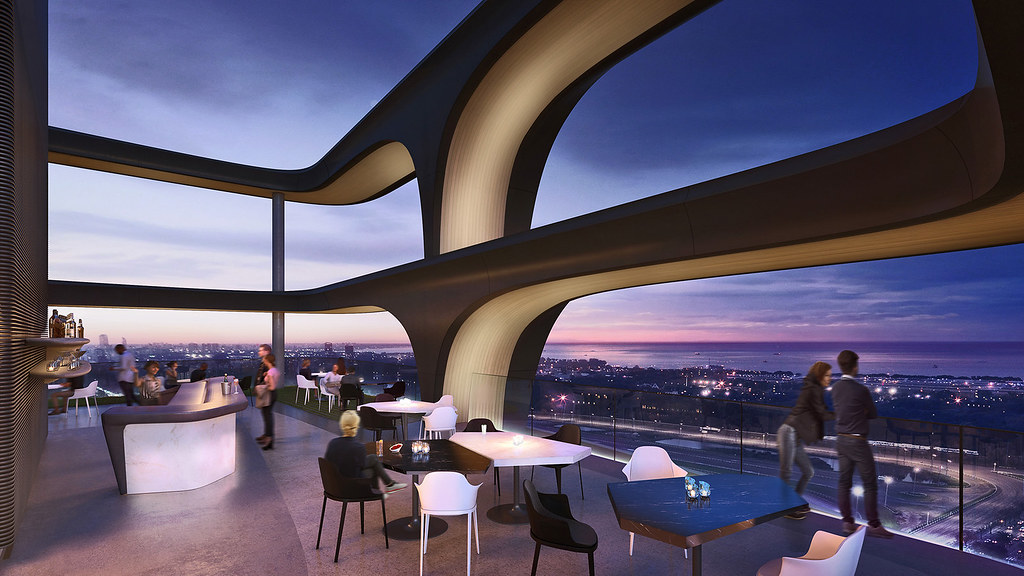From a compound of fibers and cement, it’s possible to manufacture panels and pieces of all kinds, very lightweight and with various shapes and textures.
The first building by Zaha Hadid in Argentina will have curved GRC panels.
Aesthetic quality, durability, acoustic comfort, resistance to corrosion, water and moisture, impact, and fire are the qualities that GRC (Glass Reinforced Concrete) possesses. This super material could be defined as the evolution of precast concrete with the same advantages of industrialized prefabrication and without waste on-site. It also has additional qualities such as reduced weight and greater durability (it does not have iron reinforcement, and fiberglass has alkali resistance). For example, a GRC panel with its frame has a total thickness of 12 cm (1 cm of GRC, 3 cm of separation, 8 cm of frame) and weighs between 45 and 60 kg per m2. It’s also possible to form a sandwich panel (1 cm GRC, variable thickness EPS insulation, 1 cm GRC) with 60-70 kg/m².
“In Latin America, GRC is a novel material. In 2014, the Lima Convention Center was presented as one of the great challenges in terms of prefabricated concrete with lightweight facades because it was a large-scale project, with 12,000 m2, and unprecedented. Locally, there were neither the knowledge nor the factory that could solve the project,” explains Enrique Galindo, Astori’s advisor in Argentina and Uruguay, with over 25 years of experience in GRC production in Spain.
The micro cement reinforced with fiberglass was the chosen material by the designers of the Peruvian building, mainly for its low weight. The original design, with exposed concrete, implied an unviable overweight for a seismic zone. Thus, GRC became the ideal solution to address the facade engineering without affecting the aesthetics sought by the designers.
“The original design, composed of multiple perforations, evolved into the current design, composed of large volumes of cement with a ribbed texture of recesses and protrusions to hide the vertical joints,” details Galindo. In this way, the robustness in the mass was accentuated in contrast to the extensive terraces and glass surfaces.
The specialist ensures that one of the most important aspects regarding the final finish was the color selection to avoid tone differences that would occur between manufactured panels: “Finally, it was decided to use gray cement, which was key to emphasize the majestic appearance of a building with large masses of concrete,” he points out.
To meet the tight construction deadlines (the building had to be ready for the Summit of the Americas in April of this year), it was decided to produce the panels in a plant specially set up in Peru. Meanwhile, in Spain, progress was made in parallel with the assembly of the molds, also developed with GRC starting from a wooden model where the texture was reproduced.
The type of panel chosen was Stud Frame, composed of a 1 cm GRC sheet connected to a zinc-coated metal frame of tubulars, through smooth steel rod connectors. With this system, the expansion movements of the two materials that make up the panel are allowed. Virtually all of the 12,000 m2 manufactured were completed in a period of six months, leaving adjustments and interior finishes for later.
The adopted anchoring system was key to accelerating the assembly pace. “It consisted of a completely bolted system, without welding, so that personnel without experience in installations of this type could achieve quite high yields as the days went by,” explains the advisor.
In Argentina, Astori is developing GRC panels for the remodeling of the Córdoba Convention Center, and for the new airport in Tucumán, with a project by César Pelli. The bidding process includes the GRC facade of the L’Avenue Libertador tower, the first project by Zaha Hadid Architects in our country. Additionally, the double-curved panels covering the front of the slabs in the Fendi Chateau tower (Punta del Este, Uruguay) will also be coated with this composite material.
*Article written by Paula Baldo for Clarín. Original article here
